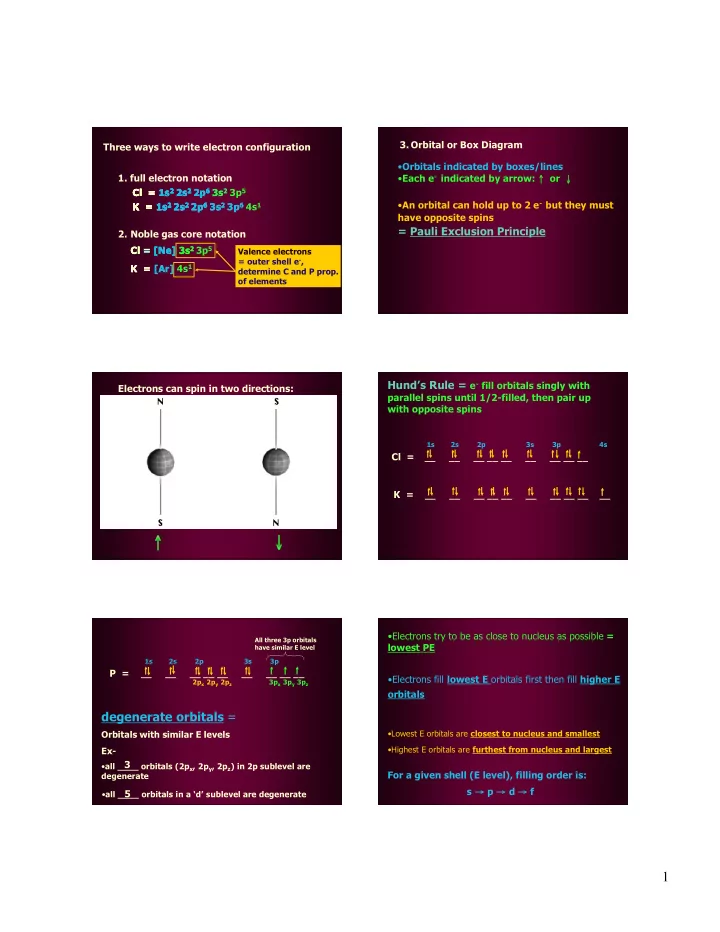

3. Orbital or Box Diagram Three ways to write electron configuration • Orbitals indicated by boxes/lines 1. full electron notation • Each e - indicated by arrow: ↑ or ↓ Cl = 1s 2 Cl = 1s 2 2s 2 Cl = 1s 2 2s 2 2p 6 Cl = 1s 2 2s 2 2p 6 3s 2 Cl = 1s 2 2s 2 2p 6 3s 2 3p 5 • An orbital can hold up to 2 e - but they must K = K = 1s 2 K = 1s 2 2s 2 K = 1s 2 2s 2 2p 6 K = 1s 2 2s 2 2p 6 3s 2 K = 1s 2 2s 2 2p 6 3s 2 3p 6 K = 1s 2 2s 2 2p 6 3s 2 3p 6 4s 1 have opposite spins = Pauli Exclusion Principle 2. Noble gas core notation Cl = [Ne] Cl = [Ne] 3s 2 3p 5 Cl = Cl = [Ne] 3s 2 Valence electrons = outer shell e - , K = [Ar] 4s 1 K = [Ar] K = determine C and P prop. of elements Hund’s Rule = e - fill orbitals singly with Electrons can spin in two directions: parallel spins until 1/2-filled, then pair up with opposite spins 1s 2s 2p 3s 3p 4s Cl = __ __ __ __ __ __ __ __ __ K = __ __ __ __ __ __ __ __ __ __ ↓ ↑ •Electrons try to be as close to nucleus as possible = All three 3p orbitals lowest PE have similar E level 1s 2s 2p 3s 3p P = __ __ __ __ __ __ __ __ __ •Electrons fill lowest E orbitals first then fill higher E 2p x 2p y 2p z 3p x 3p y 3p z orbitals degenerate orbitals = •Lowest E orbitals are closest to nucleus and smallest Orbitals with similar E levels •Highest E orbitals are furthest from nucleus and largest Ex- 3 • all ____ orbitals (2p x , 2p y , 2p z ) in 2p sublevel are For a given shell (E level), filling order is: degenerate s → p → d → f 5 • all ____ orbitals in a ‘d’ sublevel are degenerate 1
d sublevel lags one period behind Fe: 1s 2 2s 2 1s 2 2s 2 2p 6 3s 2 3p 6 4s 2 3d 6 1s 2 2s 2 2p 6 3s 2 3p 6 4s 2 1s 2 2s 2 2p 6 3s 2 3p 6 1s 2 2s 2 2p 6 3s 2 1s 2 2s 2 2p 6 1s 2 f sublevel lags two periods behind Subshell Filling Order Lowest E 1s → 2s → 2p → 3s → 3p → 4s → 3d → 4p → 5s → 4d → 5p → 6s → 4f → 5d → 6p → 7s → 5f → 6d → 7p Highest E Shape of Orbitals •s orbitals are spherical •p orbitals are figure eight shaped (2 lobes) •d orbitals are cloverleafed (4 lobes) 2
An atom has: Ions 2 e - in 1st energy level 8 e - in 2nd energy level Electron configuration # valence electrons 7 e - in 3rd energy level Cl Which element is it? 7 F = 1s 2 2s 2 2p 5 1s 2s 2p 3s 3p ? = 8 F - F - = 1s 2 2s 2 2p 6 __ __ __ __ __ __ __ __ __ __ F - has same configuration as a noble gas (Ne) 11 Total # e - in p-orbitals? Na Na = 1s 2 2s 2 2p 6 3s 1 1 How many unpaired e - are there? 1 Total number of e - in s-orbitals? 6 Na + Na + = 1s 2 2s 2 2p 6 8 Na + has same configuration as (Ne) Na + , F - and Ne all have the same configuration Excited state electron configuration isoelectric = atoms/ions with same e - configuration •When an e - is in a higher E level than normal These ions are all •Happens when element heated or exposed to isoelectric: Atoms: electrical current Ca: [Ar] 4s 2 Ca +2 •e - jump from inner shell orbital (low E) to outer shell orbital (higher E) K: [Ar] 4s 1 K +1 •What happens when e - falls back to appropriate Ar: [Ne] 3s 2 3p 6 Ar [Ne] 3s 2 3p 6 orbital? Gives off EM radiation (light) Cl: [Ne] 3s 2 3p 5 Cl -1 Excited state Ground state light F = [He] 2s 2 2p 4 3s 1 F = [He] 2s 2 2p 5 S: [Ne] 3s 2 3p 4 S -2 3
Summary of electron configuration Excited or ground state? Energy Allowed # orbitals # electrons insubshell Level subshells in subshell ground 1s 2 2s 2 2p 6 3s 1 2 1 1 s 1 2 s 1 2 2 1s 2 2s 2 2p 6 3s 2 3p 4 3s 1 1s 2 2s 2 2p 6 3s 2 3p 4 3s 1 excited 2 p 3 6 1s 2 2s 2 2p 6 3s 2 3p 5 2 3 s 1 1s 2 2s 1 2p 6 1s 2 2s 1 2p 6 excited 3 3 p 3 6 1s 2 2s 2 2p 5 5 10 3 d 1s 2 2s 2 2p 6 3s 2 3p 6 4s 1 ground 1 4 s 2 3 4 p 6 4 1s 2 2s 1 2p 6 3s 2 3p 2 1s 2 2s 1 2p 6 3s 2 3p 2 excited 5 4 d 10 1s 2 2s 2 2p 6 3s 2 3p 1 4 f 7 14 4
Recommend
More recommend